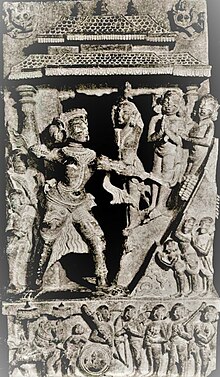
Back नरसिंह देव प्रथम Hindi ପ୍ରଥମ ନରସିଂହ ଦେବ OR முதலாம் நரசிங்க தேவன் Tamil Нарасімхадева I Ukrainian نرسنگھا دیو اول Urdu
This article needs additional citations for verification. (September 2022) |
| 'Gajapati' Narasingha Deva I | |
|---|---|
| Yavanabaniballava, Hammiramanamardana, Gajapati, Paramamaheswara, Durgaputra, Purushottamaputra | |
 Broken stone panel from Konark ruins depicting Narasingha Deva I practicing archery | |
| Reign | 1238–1264 CE |
| Predecessor | Anangabhima Deva III |
| Successor | Bhanu Deva I |
| Spouse | Sita Devi (Paramara Princess of Malwa), Choda Devi (Chola Princess), etc. |
| House | Eastern Ganga Dynasty |
| Father | 'Rauta' Anangabhima Deva III |
| Mother | Kastura Devi |
| Religion | Hindu |
Gajapati Langula Narasingha Deva I was an Eastern Ganga monarch and a warrior of the Kalinga region who reigned from 1238 CE to 1264 CE.[1][2] He defeated the Muslim forces of Bengal who constantly threatened the Eastern Ganga dynasty's rule over his kingdom of Kalinga from the times of his father Anangabhima Deva III.[3] He was the first king from Kalinga and one of the few rulers in India who took the offensive against the Islamic expansion over India by Turko-Afghan invaders of Eastern India. His father had successfully defended his kingdom against the Turko-Afghan rulers of Bengal and crossed into Rarh, Gauda and Varendra in Bengal chasing the invaders on backfoot. He became the dominant ruler of the peninsula by defeating the Turko-Afgan, Gouda, and the powerful monarch of the south kakatiya Dynasty king Ganapati Deva,[3][4] and was one of the most powerful Hindu rulers in India. He also built the Konark temple[5] to commemorate his victories over the Muslims as well as other temples and the largest fort complex of Eastern India at Raibania in Balasore. He also built famous Varaha Lakshmi Narasimha Temple at Simhachalam,[3] Andhra Pradesh.[6][7] The Kendupatana plates of his grandson Narasingha Deva II mention that Sitadevi, the queen of Narasingha Deva I was the daughter of the Paramara king of Malwa.
- ^ Dey, Anil (2012). "No 1 - Odisha Ganga Banshara Itihasa". Arkakshetra Konarka. Vol. 1. Bhubaneswar, Odisha: Ama Odisha. pp. 17–29.
- ^ "World Heritage Sites - Konarak - Sun Temple - Introduction".
- ^ a b c "దివ్యక్షేత్రం సింహాచలం". Andhra Jyoti (in Telugu). 30 October 2022. p. 9.
- ^ Rajguru, Padmashri Dr. Satyanarayana (1986). "No 1 - Ganga o Gajapati Bansha Ra Utpatti o Sankhipta Itihasa". Odisha Ra Sanskrutika Itihasa. Vol. 4. Cuttack, Odisha: Orissa Sahitya Akademi. p. 25.
- ^ Sen, Sailendra (2013). A Textbook of Medieval Indian History. Primus Books. pp. 36–37. ISBN 978-9-38060-734-4.
- ^ The Fort of Barabati Archived 2016-09-10 at the Wayback Machine. Dr. H. C. Das. pp. 3.
- ^ Rajguru, Padmashri Dr. Satyanarayana (1975). "No 117 - Lakshmi Narasimha Temple at Simhachalam". Inscriptions of Orissa. Vol. V - Part I. Bhubaneswar, Odisha: Odisha State Museum. pp. 178–9.
© MMXXIII Rich X Search. We shall prevail. All rights reserved. Rich X Search